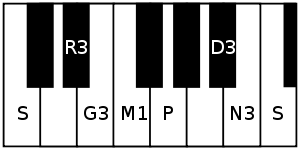Nata (raga)
| Carnatic music |
|---|
Tanjavur-style Tambura |
| Concepts |
| Compositions |
| Instruments |
|
Nata (nāṭa) is a rāgam in Carnatic music (musical scale of South Indian classical music). It is a janya rāgam (derived scale) from the 36th melakarta scale Chalanata. It is a janya scale, as it does not have all the seven swaras (musical notes) in the descending scale. It is a combination of the sampurna raga scale Chalanata and the pentatonic scale Gambhiranata.[1][2] It is an auspicious raga, which is mostly sung in the early part of the concert.[1]
Structure and Lakshana


Nata is an asymmetric rāgam that does not contain gandharam and dhaivatam in the descending scale. It is an sampurna-audava rāgam (or owdava rāgam, meaning pentatonic descending scale).[1][2] Its ārohaṇa-avarohaṇa structure (ascending and descending scale) is as follows:
It is a vivadi raga. The notes used in this scale are shadjam, shatsruthi rishabham, antara gandharam, shuddha madhyamam, panchamam, shatsruthi dhaivatam and kakali nishadham in ascending scale, with dhaivatam and gandharam skipped in descending scale. For the details of the notations and terms, see swaras in Carnatic music.
Popular compositions
There are many compositions set to Nata rāgam. Many compositions in praise of Lord Ganesha are set to this raga.[1] Here are some popular kritis composed in this ragam.
- The first Pancharatna Kriti Jagadananda karaka composed by Tyagaraja, the first of the 5 jewels
- Swaminadha paripalaya and Mahaganapatim by Muthuswami Dikshitar
- Karimukhavarada by G. N. Balasubramaniam
Related rāgams
This section covers the theoretical and scientific aspect of this rāgam.
References
- 1 2 3 4 Ragas in Carnatic music by Dr. S. Bhagyalekshmy, Pub. 1990, CBH Publications
- 1 2 Raganidhi by P. Subba Rao, Pub. 1964, The Music Academy of Madras